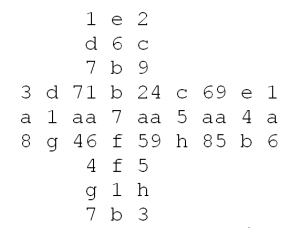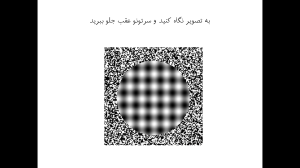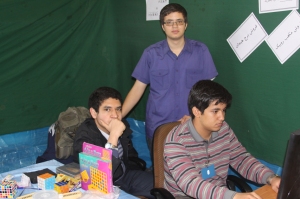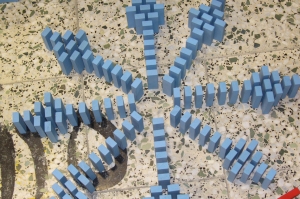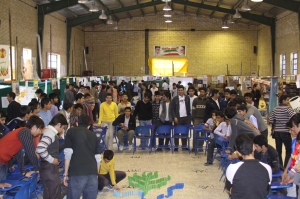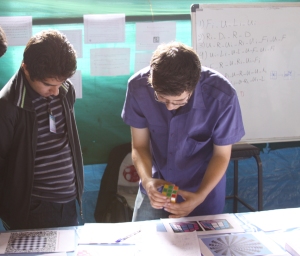با سلام خدمت همه دوستان
بالاخره بعد از یک سال که درگیر کنکور بودم امروز تونستم دوباره بیام اینجا که البته می بینم ف… شده به همین دلیل این وبلاگ را به آدرس زیر منتقل کردم
نوشته شده در Uncategorized | Leave a Comment »
فلش iq test که البته یکم قدیمی شده
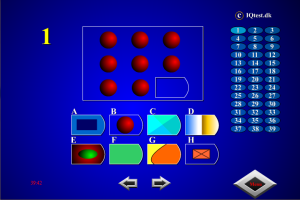 برای دانلود اونجا را کلیک کنید اگر دوست نداشتید دانلود کنید می تونید به سایت iqtest.dk مراجعه کنید.لطفا امتیازتونو برای مقایسه اعلام کنید
برای دانلود اونجا را کلیک کنید اگر دوست نداشتید دانلود کنید می تونید به سایت iqtest.dk مراجعه کنید.لطفا امتیازتونو برای مقایسه اعلام کنید
نوشته شده در بازی فلش | Leave a Comment »
نوشته شده در بازی فلش | Leave a Comment »
دوستان عزیز ما خودمون هرچه از سعی کردیم نتونستیم از روی این متن Sudokube رو حل کنیم .هر وقت حل شد انشا الله روششو می ذاریم…
Hello!
You have probably found this page because you have a «Sudokube» and want to solve it, or you just want to know what a «Sudokube» is.
The «Sudokube» or «Sudoku Cube» or «Sudoku Kube» is a Rubik’s Cube that has numbered stickers on it instead of coloured stickers. The object of the puzzle is to arrange the cube in such a way that each cube face shows the digits 1 to 9 with no duplicate digits, similar to what you might see in a 3×3 block of the popular Sudoku puzzles. The digits do not necessarily have to be in order, depending on what kind of Sudokube you have.
Solved Sudokube:

Before you start trying to solve a Sudokube, you should familiarize yourself with how to solve a standard Rubik’s Cube. I learned the Lars Petrus method, which is quite an easy method for beginners to learn. Once you have your Rubik’s Cube skills down pat, you should understand the basics of how individual cubies move around and interact with each other. At this point you should be able to figure out the secrets of the Sudokube, but in case you are still having trouble, read on.
The solution
The first thing you should realize is that once the cube is solved, all of the numbers on a given side will have the same orientation (except possibly for the one in the center — we will get to that later). Using this information, you should be able to easily figure out where all the corners should be relative to each other.
The second thing you should realize is that the centers of each face are fixed relative to each other. This is the first thing you learn about basic Rubik’s Cube solving.
Using these two pieces of information, you might be able to already figure out where all of the corners go relative to the centers. If you can, that’s great! All we need to do is figure out where the 12 edge pieces go. If the corners are still ambiguous, we will have to do more analysis involving the edge pieces.
Unsolved Sudokube:


OK, the edge pieces. For these guys we will use a combination of sticker orientation and Sudoku techniques to figure out where they go. First, let us label all of the different possible sticker orientations on the cube:
On my cube there are eight possible orientation combinations for the edge pieces. I have labelled them «aa» to «hh». I then made a list of all the edges that had matching orientations:
- aa edges: 58, 12, 37, 86
- bb edges: 38, 84
- cc edges: 33
- dd edges: 49
- ee edges: 57
- ff edges: 96
- gg edges: 29
- hh edges: 22
As you can see, there is only one possible location for six of the twelve edge pieces! That makes things much easier. For the «aa» and «bb» edges, you must call on your Sudoku skills to figure out where they go!
In my case, the final solution looked like this:

Once you have figured out where everything should go, you can use your standard
Rubik’s Cube skills to put it all into place. The only difficulty at this point is staying focussed and keeping track of what you have already solved, since it’s not obvious at first glance!
Twisting the centers
Once you have the cube «solved», you may notice that some or all of your center pieces are twisted! There are a few useful moves for fixing these up and making your cube look like new again.
- Rotate the upper center clockwise, and the front center counter-clockwise: f b› l r› u d› f› u› d l› r f› b u
Sudokube with two twisted centers:

- Rotate the upper center 180 degrees: u r l uu r› l› u r l uu r› l›
Sudokube with one twisted center:

There we go! I hope you found this useful!
نوشته شده در آموزش | 3 Comments »
تصاویر خطای دید
دانلود مجموعه ی 1 با حجم 3.8 مگابایت
دانلود مجموعه ی 2 با حجم2.1 مگابایت
pass:baziriazi.wordpress.com
اینم چنتا از عکساش:
نوشته شده در خطای دید | Leave a Comment »
اینم آموزش مکعب روبیک کاملا فارسی که ما برای شما آماده کردیم فقظ دو قسمتش کردم که راحت تر بتونید استفاده کنید
قسمت اول حدود چهار دقیقه
قسمت دوم حدود نه دقیقه
pass:baziriazi.wordpress.com
LIST OF ALGORITHMS- 1) Fi U Li Ui 2) Ri Di R D 3) U R Ui Ri Ui Fi U F 4) Ui Li U L U F Ui Fi 5) F R U Ri Ui Fi 6) R U Ri U R U U Ri 7) U R Ui Li U Ri Ui L 8 ) Ri Di R D
اگر تا حالا از رپیدشیر فابل دانلود نکرده اید اینجا را کلیک کنید
نوشته شده در آموزش | 1 Comment »
Young Clutterbuck, the junior clerk, often found himself with time on his hands. On such occasions, he would resort to a certain window pane where a circular patch of clear glass showed where the circumambient grime had been purposefully removed. Thence, through the swirling yellowish fog, he could see the clock above the gate of the Workhouse which stood across the way.
As he was thus engaged one afternoon, he observed that the hour hand was exactly on a minute mark, and that the minute hand was six minutes ahead of it. Later that afternoon, as he again stole from his desk to observe the Workhouse clock, he perceived that the hour hand was exactly on another minute mark, and now the minute hand was seven minutes ahead of it.
How much time had elapsed between Young Clutterbuck’s first and second observations?
نوشته شده در انگلیسی | Leave a Comment »
On a recent visit to the home of Mr and Mrs Crummles, I observed the Infant Phenomenon playing a solo dice game which she had invented and to which she had given the name Snakes and Escalators.
On each turn she threw a pair of normal dice. But whereas the normal procedure is to calculate the score by taking the sum of the numbers that turn up, in this game the score is the multiple of the two numbers. Thus, throwing a 3 and a 2, or a 6 and a 1, would give a score of 6; a double 5 would give a score of 25; and so on.
She did explain to me the other rules of the game, but I am afraid they exceeded my comprehension. I do, however, recall that the score for her second throw happened to be 5 more than her score for the first throw; her third score was 6 less than her second; her fourth score was 11 more than her third; and her fifth score was 8 less than her fourth.
Can you tell me what the Infant Phenomenon’s score was for each of these five throws?
نوشته شده در انگلیسی | Leave a Comment »
Bob and Benjamin were excitedly describing the result of the First Annual Pickwickian Commemorative Wheelbarrow Race at Dingley Dell.
Snodgrass, Tupman and Winkle had been the three contestants.
«Tupman won the race; Winkle was in second place,» reported Bob.
Benjamin disagreed. «It was Snodgrass who won. Tupman came second.»
In fact, neither Bob nor Benjamin had given a correct version of the result as each had made one true and one false statement.
What was the actual placing of the threee contestants?
نوشته شده در انگلیسی | Leave a Comment »
چنتا عکس از نمایشگاه مدرسه به مناسبت دهه فجر
غرفه بازی و ریاضی
آرم سمپاد که بچه ها با دومینو درست کردن

آقای ارجمند مدیر قبلی دبیرستان
نمای کلی نمایشگاه
نوشته شده در عکس های نمایشگاه | Leave a Comment »

